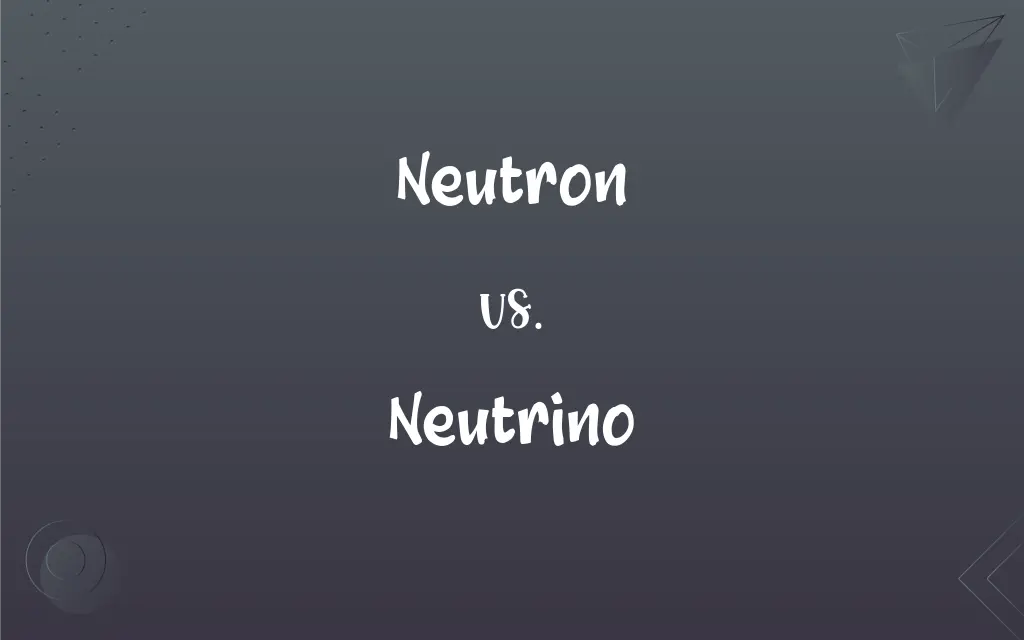Neutron vs. Neutrino: What's the Difference?
Edited by Harlon Moss || By Janet White || Published on January 30, 2024
A neutron is a subatomic particle with no electric charge, found in the nucleus of an atom, whereas a neutrino is a much smaller, neutral elementary particle that interacts weakly with matter.

Key Differences
A neutron is a subatomic particle located in the nucleus of an atom, contributing to its mass but having no electric charge. A neutrino is a fundamental particle of the universe, known for its extremely small mass and lack of electric charge, primarily interacting through the weak nuclear force.
The neutron was discovered in 1932 by James Chadwick, proving to be essential in the atomic nucleus's stability. Neutrinos, predicted by Wolfgang Pauli in 1930 and discovered in 1956, are elusive due to their weak interactions with matter.
Neutrons play a crucial role in nuclear reactions and stability of atoms. Neutrinos, often produced in nuclear reactions, are pivotal in studying astrophysical phenomena due to their ability to pass through matter almost unhindered.
Neutrons have a significant mass, nearly equal to that of protons. Neutrinos are incredibly light, almost massless, and rarely interact with other particles, making them difficult to detect.
Neutron studies are vital in understanding atomic structure and nuclear physics. Neutrino research offers insights into the workings of the universe, from the Sun's core to distant supernovae.
ADVERTISEMENT
Comparison Chart
Charge
Neutral (0 electric charge)
Neutral (0 electric charge)
Location
Found in the nucleus of atoms
Travels freely through space
Mass
Comparable to proton (significant mass)
Almost massless
Interaction with Matter
Interacts strongly via nuclear forces
Interacts weakly, mostly via weak nuclear force
Discovery Year
Discovered in 1932
Predicted in 1930, discovered in 1956
ADVERTISEMENT
Neutron and Neutrino Definitions
Neutron
A neutron is a neutral particle in an atom's nucleus.
The number of neutrons defines an isotope of an element.
Neutrino
A neutrino is a very light, neutral subatomic particle.
Neutrinos are produced in abundance in nuclear reactions like those in the Sun.
Neutron
Neutrons act as a stabilizer in the nucleus, preventing protons from repelling each other.
Heavy elements have more neutrons to counterbalance the repulsion between protons.
Neutrino
Neutrinos interact with matter only via the weak nuclear force.
Neutrinos can pass through Earth without any interaction.
Neutron
Neutrons are fundamental components of atomic nuclei.
Neutrons and protons are bound together in the nucleus by the strong nuclear force.
Neutrino
Neutrinos are elusive particles, challenging to detect due to their weak interactions.
Neutrino detectors often require large volumes of water or ice to capture rare interactions.
Neutron
A neutron is a subatomic particle with no charge and a mass slightly greater than that of a proton.
Nuclear reactions often involve the release or absorption of neutrons.
Neutrino
Neutrinos are fundamental particles in the standard model of particle physics.
The study of neutrinos can reveal new physics beyond the standard model.
Neutron
Neutrons are key players in nuclear fission and fusion processes.
Fission reactors use neutrons to initiate the splitting of atomic nuclei.
Neutrino
Neutrinos come in three types or flavors: electron, muon, and tau neutrinos.
Each type of neutrino is associated with a corresponding lepton.
Neutron
The electrically neutral nucleon, a baryon composed of two down quarks and one up quark, which has a mass 1,839 times that of an electron, is stable when bound in an atomic nucleus, but has a mean lifetime of 886 seconds as a free particle. It is a basic component of all atomic nuclei except the protium isotope of hydrogen.
Neutrino
Any of three electrically neutral leptons (the electron neutrino, muon neutrino, and tau neutrino—one in each of the three generations of elementary fermions) that have very small masses.
Neutron
(particle) A subatomic particle forming part of the nucleus of an atom and having no charge; it is a combination of an up quark and two down quarks.
Neutrino
An elementary particle that is classified as a lepton, and has an extremely small but nonzero mass and no electric charge. It interacts with the surroundings only via the weak force or gravitation, making it very difficult to detect.
Neutron
An elementary particle with 0 charge and mass about equal to a proton; enters into the structure of the atomic nucleus
Neutrino
An elementary particle with zero charge and zero mass
FAQs
What role do neutrons play in the atom?
Neutrons contribute to the mass of an atom and stabilize the nucleus.
Can neutrinos be detected?
Yes, though challenging, neutrinos can be detected using specialized equipment.
What is the mass of a neutron?
A neutron has a mass slightly greater than that of a proton.
Are neutrons involved in nuclear reactions?
Yes, neutrons play a significant role in nuclear fission and fusion.
What is a neutron?
A neutron is a subatomic particle found in the nucleus of atoms, neutral in charge.
What is a neutrino?
A neutrino is a very light, neutral elementary particle that interacts weakly with matter.
How were neutrons discovered?
Neutrons were discovered in 1932 by James Chadwick.
Do neutrons have a charge?
No, neutrons have no electric charge.
What role do neutrinos play in physics?
Neutrinos are key to studying fundamental physics and astrophysical processes.
Are there different types of neutrinos?
Yes, there are three types: electron, muon, and tau neutrinos.
How were neutrinos discovered?
Neutrinos were predicted in 1930 and discovered in 1956 by Clyde Cowan and Frederick Reines.
Do neutrinos have a charge?
No, neutrinos are electrically neutral.
Why are neutrinos important in astrophysics?
Neutrinos provide valuable information about cosmic events and the internal processes of stars.
What is neutron decay?
Neutron decay is the process where a neutron breaks down into a proton, an electron, and an antineutrino.
Can neutrinos change type?
Yes, neutrinos can oscillate between different flavors or types.
Why are neutrons important in nuclear reactors?
Neutrons are essential in initiating and sustaining the nuclear fission process in reactors.
How do neutrinos interact with other particles?
Neutrinos interact with other particles primarily through the weak nuclear force.
What is the mass of a neutrino?
Neutrinos are almost massless, though not completely.
Where are neutrons found in nature?
Neutrons are found in the nuclei of most atoms.
Where do neutrinos come from?
Neutrinos are produced in nuclear reactions, such as those in the Sun, supernovae, and nuclear reactors.
About Author
Written by
Janet WhiteJanet White has been an esteemed writer and blogger for Difference Wiki. Holding a Master's degree in Science and Medical Journalism from the prestigious Boston University, she has consistently demonstrated her expertise and passion for her field. When she's not immersed in her work, Janet relishes her time exercising, delving into a good book, and cherishing moments with friends and family.
Edited by
Harlon MossHarlon is a seasoned quality moderator and accomplished content writer for Difference Wiki. An alumnus of the prestigious University of California, he earned his degree in Computer Science. Leveraging his academic background, Harlon brings a meticulous and informed perspective to his work, ensuring content accuracy and excellence.







































































